


Murder in White! A tragic fall -- an impending operation -- strangulation! When Abigail Doorn was wheeled into the operation room at the Dutch Memorial Hospital, her face was strangely blue and bloated. A wire had been tightly wound around her neck. The strongest suspect, because he stood to benefit by the death of this wealthy old woman, was her protégé, the famous Dr. Janney. Just before her death he received a strange caller -- one whose name he would not divulge. Ellery Queen, having come to the hospital to visit his old friend Dr. Minchen, had been present during the time of the murder. He immediately took over the case. Besides the problem of Dr. Janney and his caller, Ellery found himself confronted with still another -- why had Abby Doorn and her housekeeper quarreled continuously for 20 years? The housekeeper admitted she hated the old woman, and with a religious fanaticism declared she was an evil old woman who had received only what she deserved. |
|
| "Carefully constructed ... deserves to be savored."
--
The London Times "It has everything needed to make it great." -- Philadelphia Ledger "A few detective stories stand out from the inky welter of crime, notably 'The Dutch Shoe Mystery'... a splendid story... with real flesh and blood actors, and written with verve and style." -- Morning Post "The book is thoroughly engrossing." -- Bruce Nae, The New York Times |
|
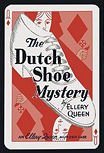    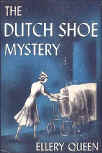  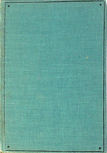 |
|
|
Above: The first books published sometimes had
identical front covers. The spine of the books/dust cover only differ in the
publisher's logo. Top row left to right: dust and hardcover for
Stokes edition, dust and hardcover Grosset & Dunlap edition. Bottom row from left to right: dust cover for the Triangle reprints, which had several hard cover versions, with different designs/colours or either "Triangle" or "Blakiston/ Triangle" imprinted on the spine. At least 12 printings exist between January 1940 and July 1943. (Click on the covers to see the differences*) |
|
|
Buffalo Evening News, "Thrill and Ingenuity"
December 12. 1931 " 'There are only two detectives,' writes a Viennese police consultant, 'for whom I have felt, in my own capacity as hunter-of-men, any deeply underlying sympathy. These two, strangely enough, present the weird contrast of unreality, of phantom and fact. I refer of course to those imperishables -  Mr. Sherlock Holmes of Baker Street, London
and Mr. Ellery Queen of West 87th street, New York City.' Mr. Sherlock Holmes of Baker Street, London
and Mr. Ellery Queen of West 87th street, New York City.'With the appearance of his third detective story, this author who uses such an intriguing pen-name fulfills the promise predicted for him by the London Times that 'Ellery Queen is the most logical successor of Sherlock Holmes.' All ardent readers of detective fiction will remember 'The French Powder Mystery', where at high noon, the corpse of a beautiful woman suddenly tumbles into the window of a Fifth Avenue department store; and 'The Roman Hat Mystery', a murder in a theater, as smoothly performed as the play which is in progress. Ellery Queen is equally famous for his unusual and striking settings and for the manner in which he employs the process of deduction. In his latest tale, the richest woman in America is about to have performed upon her a most delicate operation to be done by a young doctor whom she has had educated. In the great operating room of the vast hospital which she has founded, relatives, friends, and even curious acquaintances wait anxiously to learn the result of the operation. The surgeon calls for his patient and a covered form is wheeled in on a stretcher into the amphitheater. The doctor bends over and finds the woman has been murdered only a few moments before... Who did this ghastly deed, and who wore the Dutch shoes? Vital and refreshing, this absorbing tale will keep the most hardened detective fan up until the 'wee small' hours." |
|
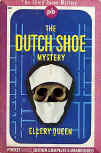      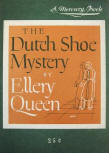  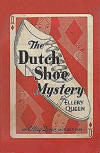 |
|
|
Ellery Queen’s The Dutch Shoe Mystery
(1931) is the third and last of his apprentice works, and it firmly establishes Queen as
a master of the classical detective puzzle. What begins as a straightforward
hospital drama soon spirals into an intricate mystery that delivers both
intellectual satisfaction and the eerie, otherworldly touch that marks the
best of Queen’s early work. The story opens in the sterile, white corridors of the Dutch Memorial Hospital—a setting that provides much more than a backdrop. It becomes a symbolic space of order, rationality, and, paradoxically, hidden chaos. When Abigail Doorn, a wealthy philanthropist and one of the richest women in America, is wheeled into the operating room for a delicate surgery, everyone present is stunned to discover that she is already dead—strangled with wire moments before the procedure. The operating theater, about to witness a life-saving miracle, instead hosts a murder scene. Ellery Queen, present by coincidence while visiting a friend, takes the reins of the investigation, diving headfirst into a mystery steeped in motive, opportunity, and psychological complexity. Michael E. Grost explained that the brilliance of The Dutch Shoe Mystery lies in its opening chapters. The initial ten chapters are particularly taut, delivering not just the central murder, but a vibrant cast of suspects, a compelling floor plan (a hallmark of Golden Age detective fiction), and Queen’s meticulous style of deduction. Queen’s surrealistic flair is evident in the startling presentation of the corpse and the all-encompassing whiteness of the hospital setting. The atmosphere becomes almost abstract, evoking images of Malevitch’s ** White on White and suggesting a visual metaphor of purity invaded by violence. This “white-out” motif lends the novel a visionary quality that is rare among even the most imaginative detective stories. |
|
| ** Malevich, Kasimir (1878-1935) Russian painter who died in poverty and oblivion. | |
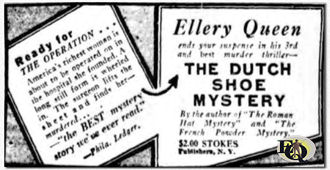 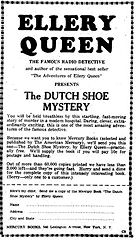 Above left: Add in the The New York Sun, October 16. 1931 for Stokes' The Dutch Shoe Mystery. Above right: In the Summer of 1940 this add with coupon was printed in several newspapers. For a 10c (postage and handling) or a dime 3,000 readers could request their copy of "The Dutch Shoe Mystery" (Mercury Books, The American Mercury). |
|
|
At the center of the investigation stands Dr. Janney, the surgeon scheduled to perform the operation and Abigail Doorn’s protégé. He becomes an immediate suspect—not least because he was the last known person to have received a mysterious caller before the murder, a visitor whose identity he refuses to reveal. Also of interest is the housekeeper, a religious zealot who has quarreled with Doorn for twenty years and chillingly proclaims that her employer’s death was divinely deserved. Her fervent character is one of the novel’s most memorable, and Queen—unusually for the time—balances her fanaticism with nuanced reflections on religion, foreshadowing themes that would appear in later works. While the middle portion of the novel lingers on character studies and motive development, it does slow down somewhat, a common trait in Queen’s early books. However, the narrative regains its pace in the final chapters with a clever and satisfying denouement. The solution—rooted in a breakdown of identity and classic timetable misdirection—reflects the influence of the Freeman-Crofts school of deduction, but Queen brings his own intuitionist flair to the logic. The careful movement of characters through the hospital's floor plan recalls G.K. Chesterton’s love for shifting space and perception, further reinforcing Queen’s place in the intellectual tradition of detective fiction. It is one of the fullest imitations of S.S. Van Dine's mannerisms in the Queen canon. |
|
|
Critics of the time were effusive. The
London Times declared it “carefully
constructed … deserves to be savored,” while the
Philadelphia Ledger noted that it
“has everything needed to make it great.” The
Morning Post praised the
flesh-and-blood realism of its characters, and
The New York Times called it “thoroughly
engrossing.” Perhaps the most telling tribute comes from a Viennese
police consultant, who ranked
|
|
|
The
Brooklyn Daily Eagle, William M. Isaacs - Sunday March 27. 1932 " 'You Can't Win Even in Book - Crooks Get Theirs, as Reader Raises Goose Pimples Over Them.' A well-composed detective story is Ellery Queen's 'The Dutch Shoe Mystery' (Frederick A. Stokes Co.). In this, Queen, who is the detective as well as the author, is confronted with a seemingly inexplicable problem. While paying a visit to the Dutch Memorial Hospital he is invited to witness an operation upon one of the richest and most famous women in America. The operating theater is ready, the small audience is seated, the surgeon calls for his patient. She is wheeled in and placed upon the operating table. The covering sheet is taken off, the patient is dead—strangled. Who could have committed this crime when the victim had been constantly attended? The answer to this is carefully and acceptably worked out. The story has just enough action to keep it interesting." |
|
|
Even beyond the page, the book had a surprising afterlife. A loose 1941 film adaptation (Ellery Queen and the Murder Ring) would follow, though it strayed significantly from the source material. In the 1980s, Spinnaker Software adapted its plot into the interactive game Operation MURDER, inviting players to solve the case using multimedia clues—a testament to the enduring intrigue of its puzzle.
The Dutch Shoe Mystery may not
have the flamboyance of Queen’s later novels, but it showcases the solid
foundation of his craft. It combines the elegance of deduction with an
almost cinematic visual sensibility and a hauntingly original setting. While
some may argue the novel is a novella stretched a bit thin, the core mystery
is more than strong enough to hold up. With this third outing,
|
|
|
Elements for "The Game" The story starts off on a Monday in January. Is set in NY, at the Dutch Memorial Hospital on Center Street- East 60. The Doorn's house is situated on Fifth Avenue opposite Central Park. Abigail Doorn is strangled with a wire (iron). Ellery still using the pince-nez and walking-stick is smoking a pipe and sometimes is surrounded with cigarette smoke. We learn he can't stand the sight of blood. Ellery is said to have written the manuscript of "the Murder of the Marionettes" under his own name. A young Djuna is present as is Dr. Prouty, Sampson and Cronin. The NYPD is represented by Hesse, Ritter and Velie. Pete Harper a journalist is introduced. All chapter titles end in -ion (variation, explication,...). A Challenge to the Reader is included. Later in Ten Day's Wonder a case in a NY operating theater is recalled. |
|
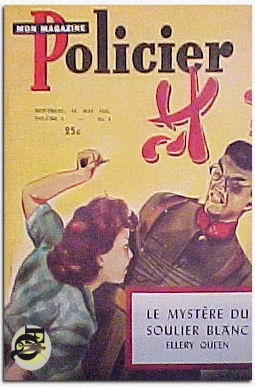 |
   |
|
Above left: French magazine Mon Magazine Policier (Revue Moderne)
published in Montreal, Canada, 1944-45 (?). It featured Le Mystere du
soulier blanc. Above right: Молодая Гвардия Russian monthly literary, artistic and socio-political magazine of the Komsomol Central Committee "Young Guard", Issue 5, 6 and 7 of 1979 had The Dutch Shoe Mystery in it. |
|

|
The Dutch Shoe
Mystery Translations: |
|
Other articles on this book (1) The Green Capsule Noah Stewart (Dec 2017) (2) Mysteries Ahoy! Aiden Brack (Jan 2018) (3) Reading Ellery Queen Jon Mathewson (Mar 2013) (4) My Reader's Block Bev Hankins (Oct 13. 2019) (5) Tale of Two Shoes Ho-Ling (May 11. 2013) (6) Noah's Archives Noah Stewart (Jul 23. 2017) (7) JetBlackDragonFly... the man who read too much (Oct 1. 2015) |
|
*
Interested readers should know
that the icons/covers
of books, used throughout the
website have extra
descriptions/information not
included in the text on the same
page. Pointing your cursor at
the icon/cover used to reveal
this extra information. To achieve the same effect Firefox users can install an add-on called 'Popup ALT Attribute'. When installed pointing your cursor at an icon/cover results in showing you the details or additional information. |
|
Copyright © MCMXCIX-MMXXV Ellery Queen, a website on deduction. All rights reserved. |